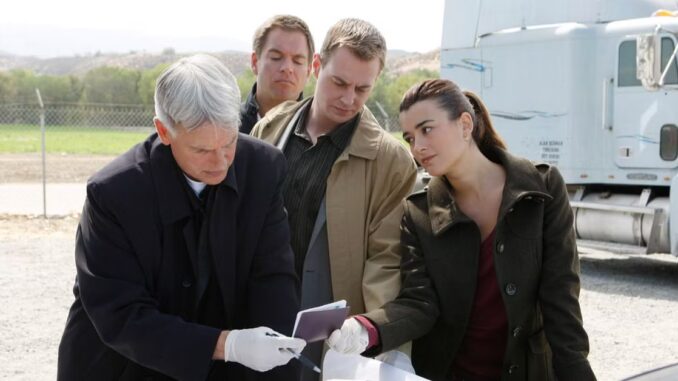
A Show Born from a Spin-Off — and Almost Lost to History
When NCIS premiered in 2003, no one expected it to redefine television. It was the quiet younger sibling of JAG, a military legal drama with moderate ratings and a loyal niche audience. But what NCIS became — a cultural juggernaut with over 450 episodes, global syndication, and five spin-offs — was never the plan.
In fact, the show that now stands as one of TV’s longest-running dramas almost didn’t exist in its current form. If star and executive producer Mark Harmon had gotten what he was originally promised, NCIS would have looked — and felt — completely different.
The Show That Could Have Been: “Based on Real Cases”
When Harmon first signed on to lead the show as Special Agent Leroy Jethro Gibbs, he was drawn to its promise of realism.
“They told me this would be a show based on true Navy and Marine Corps cases,” Harmon recalled. “That’s what I said yes to. That’s what hooked me.”
The early pitch was gritty and grounded — a series exploring the real Naval Criminal Investigative Service. Authentic. Procedural. More “documentary-style thriller” than glossy network drama.
But within months of production, that version of NCIS quietly disappeared.
“The truth is, you can’t sell a TV show on real bureaucracy,” Harmon later admitted with a laugh. “People want story. They want character. They want someone to root for.”
So the show pivoted — hard.
How “Real” Turned into “Television Gold”
The early episodes of NCIS were procedural, even stiff. The writing room soon realized that audiences weren’t connecting with the military details or naval lingo — they were connecting with the people.
By Season 2, the show evolved into something more dynamic. It was still about solving crimes, but now it was about the team: their loyalty, banter, heartbreaks, and unspoken family ties.
The murder cases became a backdrop for what NCIS really wanted to explore — the emotional toll of service, loss, and justice.
This subtle tonal shift turned a modest spinoff into a worldwide phenomenon.
The Real NCIS vs. the TV NCIS
The real Naval Criminal Investigative Service, headquartered in Quantico, Virginia, deals with everything from terrorism to internal misconduct. But, as NCIS communications director MaryAnn Cummings once said, “It’s not like the TV version. There are no car chases, no Abby Sciutos running a glowing lab, and definitely no Ducky performing autopsies for drama.”
Real NCIS agents are quiet professionals — detectives working long hours in anonymity.
And yet, those same agents have said they love the show.
“It’s Hollywood,” Cummings admitted. “But it’s also given people a glimpse of what we do — even if it’s through a funhouse mirror.”
The Mark Harmon Effect: Finding Humanity in Procedure
Harmon brought something rare to Gibbs — stoicism mixed with heart. Viewers didn’t just watch Gibbs solve cases; they watched him carry them. His grief, his integrity, his silent father-figure energy became the show’s emotional spine.
Behind the scenes, Harmon was as protective of NCIS as Gibbs was of his team. He reportedly fought for storylines that kept the show grounded and character-driven, even as it became flashier with time.
“We weren’t the biggest show right away,” Harmon said. “It took years — years of changes, of getting the balance right between case and character. But once we did, we never looked back.”
By Season 3, with fan-favorite additions like Cote de Pablo’s Ziva David and Michael Weatherly’s Tony DiNozzo, NCIS found its magic formula: a workplace family bound by loyalty and loss.
The Pivot That Built an Empire
That decision — to embrace heart over strict realism — changed everything.
By 2008, NCIS had become the most-watched show on U.S. television, surpassing even CSI in global popularity. It wasn’t just a hit; it was comfort TV, a procedural with soul.
And it didn’t stop there. The NCIS universe expanded into NCIS: Los Angeles, NCIS: New Orleans, NCIS: Hawai’i, and now NCIS: Origins — the prequel that circles back to where it all began: Gibbs’ early days in 1990, when the agency was still known as NIS.
The Full Circle Moment: “NCIS: Origins”
Two decades later, Harmon is finally getting the show he was promised. As executive producer and narrator of NCIS: Origins, he’s telling the story that first drew him in — the real agency, the real stakes, and the early 1990s world of naval crime-solving before high-tech labs and holographic screens.
“It’s been historically interesting,” Harmon said. “This time, we’re learning about the agency — and Gibbs — in a way I never got to when we first started.”
It’s poetic symmetry: the man who shaped NCIS as a global hit now returning to honor the realism it once left behind.
Would the “Real” Version Have Worked?
Maybe not. A show rooted purely in real NCIS case files might have been fascinating, but it likely wouldn’t have lasted two decades.
Fans didn’t fall in love with NCIS because of its naval jargon — they fell in love with the people. With Gibbs’ head slaps. With Abby’s hugs. With Ducky’s charm and McGee’s awkwardness. With Tony and Ziva’s will-they-won’t-they.
The real NCIS is full of heroes. But the TV NCIS gave those heroes faces, flaws, and humanity.

Legacy: The Show That Defined a Generation
NCIS is more than a procedural — it’s a symbol of enduring storytelling. A reminder that formulas evolve, and sometimes, what starts as “based on real cases” ends up becoming something realer: a reflection of loyalty, duty, and found family.
As Harmon himself once said, “Gibbs isn’t me. But he’s a part of me. And maybe that’s what keeps it human.”
After 23 years, the fire still burns — not just in the cases, but in the connection between audience and story. And maybe, just maybe, that’s the real investigation that NCIS solved better than anyone else.
